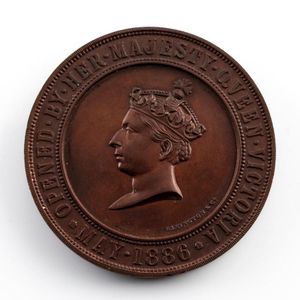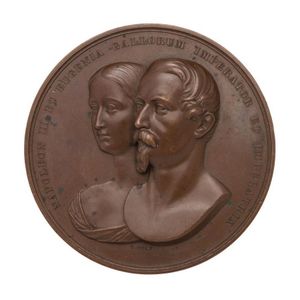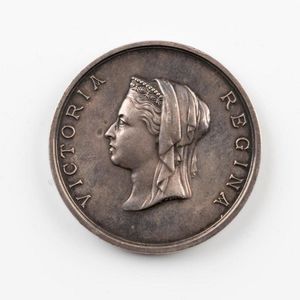Victorian Gentleman Oval Portrait in Brass Frame
You must be a subscriber, and be logged in to view price and dealer details.
Subscribe Now to view actual auction price for this item
When you subscribe, you have the option of setting the currency in which to display prices to $Au, $US, $NZ or Stg.
- Ivory - Ivory is a hard white material that comes from the tusks of elephants, mammoth, walrus and boar, or from the teeth of hippopotamus and whales. The ivory from the African elephant is the most prized source of ivory. Although the mammoth is extinct, tusks are still being unearthed in Russia and offered for sale.
Ivory has been used since the earliest times as a material for sculpture of small items, both in Europe and the east, principally China and Japan.
In Asia ivory has been carved for netsuke, seals, okimono, card cases, fan supports, animals and other figures and even as carved tusks.
In the last 200 years in Europe ivory has been used to carve figures, for elaborate tankards, snuff boxes, cane handles, embroidery and sewing accessories, in jewellery and as inlay on furniture. Its more practical uses include being used for billiard balls, buttons, and a veneers on the top of piano keys.
The use and trade of elephant ivory have become controversial because they have contributed to Due to the decline in elephant populations because of the trade in ivory, the Asian elephant was placed on Appendix One of the Convention on International Trade in Endangered Species (CITES), in 1975, and in January 1990, the African elephant was similarly listed. Under Appendix One, international trade in Asian or African elephant ivory between member countries is forbidden. Unlike trade in elephant tusks, trade in mammoth tusks is legal.
Since the invention of plastics, there have been many attempts to create an artificial ivory - Victorian Period - The Victorian period of furniture and decorative arts design covers the reign of Queen Victoria from 1837 to 1901. There was not one dominant style of furniture in the Victorian period. Designers used and modified many historical styles such as Gothic, Tudor, Elizabethan, English Rococo, Neoclassical and others, although use of some styles, such as English Rococo and Gothic tended to dominate the furniture manufacture of the period.
The Victorian period was preceded by the Regency and William IV periods, and followed by the Edwardian period, named for Edward VII (1841 ? 1910) who was King of the United Kingdom and the British Dominions and Emperor of India for the brief period from 1901 until his death in 1910.
This item has been included into following indexes:
-
miniatures
- on ivory 353
- portrait and other 1,198
- Victorian 364
Visually similar items

A superb example of the bronze medal issued to commemorate 'the Colonial & Indian Reception At the Guildhall - London 1886' in embossed case of issue. Also, a bronze medal issued for the 'International Exhibition of Navigation, Travelling, Commerce & Manuf

England: Reception of Napoleon III and Empress Eugenie At the Guildhall, London, April 1855. Bronze medal by Benjamin Wyon. 1855, Bronze, 76 mm; 249g. Obv: Conjoined busts of Emperor Napoleon III and Empress Eugenie: Napoleon III Et Eugenia Gallorum Impera

Prize medal in bronze. Obverse: Veiled head of Queen Victoria wearing a diadem (left). Legend: 'Victoria Regina'. Reverse: A seated male figure holding an olive branch and compasses, inscribed 'Invention' and a female figure holding a lyre inscribed 'Mvsic

An Antique brooch with hand-painted miniature on an oval ivory panel, depicting a lady with bonnet, glazed locket compartment to reverse. Yellow and rose gold. Length 48 mm. Width 39 mm.
